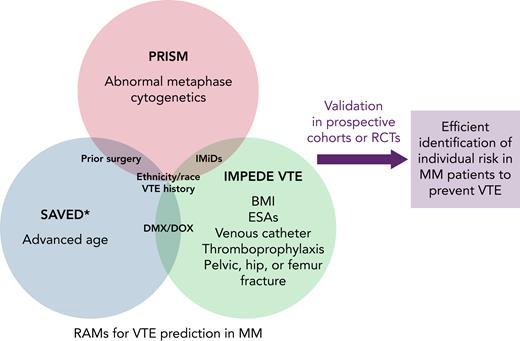In this issue of Blood, Chakraborty et al1 present a new risk prediction model—the PRISM score—for the prevention of venous thromboembolism (VTE) in outpatients with multiple myeloma (MM). This model includes an interesting new disease-related risk factor, abnormal metaphase cytogenetics, which has not been addressed until now. Understanding this risk factor will help expand our skills in treating patients with MM.
The strength of the PRISM model relies on other identified risk factors for 12-month VTE (ie, previous VTE, previous surgery, use of immunomodulatory imide drugs [IMiDs], and Black race), which are universally available at diagnosis. This model was developed in a population that was representative of real demographics in the context of a modern approach to anti-myeloma therapy.
For patients with cancer who receive outpatient treatment, accurate risk stratification for VTE is very important. In this population, the incidence of VTE is significant but extremely variable. To avoid undesirable bleeding complications with anticoagulant drugs in patients with very-low-risk disease, current guidelines do not routinely recommend thromboprophylaxis to all patients, but only to high-risk ambulatory patients with cancer identified by a validated risk prediction model.2-4 In this scenario, patients with MM, which carries a high risk of VTE,5 are an exception, because some form of thromboprophylaxis is considered for all groups, whether the patients are at low, intermediate, or high risk. The risk stratification in MM is predominantly based on a simplified algorithm from the consensus guidelines of the International Myeloma Working Group (IMWG), the National Comprehensive Cancer Network (NCCN), and the European Myeloma Network (EMN),6-8 in which the use of IMiDs is considered a major risk factor for VTE. Indeed all recent guidelines recommend VTE prophylaxis in patients with MM who are receiving IMiDs, along with the type and intensity of antithrombotic drug interventions, including oral anticoagulants (either vitamin K antagonist or apixaban), low-dose aspirin, or low molecular weight heparin, established according to the individual risk of thrombosis.2-4
However, the persistent high rate of VTE in spite of thromboprophylaxis has prompted a continuing search for new more efficient risk assessment scores. The existing Khorana score, nonspecific for MM, did not perform well in these patients,9 whereas 2 recent risk prediction scores specific for patients with MM —SAVED10 and IMPEDE VTE11—performed better than IMWG, NCCN, or EMN algorithms.
The IMPEDE VTE risk assessment model considers the following variables: therapy with IMiDs; body mass index ≥25 kg/m2; pelvic, hip, or femur fracture; erythropoietin-stimulating agent; treatment with dexamethasone or doxorubicin; Asian race/ethnicity; history of VTEs; tunneled line or central venous catheter; and existing thromboprophylaxis. In parallel, the SAVED score, a 5-point model developed only for patients receiving therapy with IMiDs, includes Asian race/ethnicity, previous surgery, age 80 years or older, history of VTEs, and treatment with standard or high-dose dexamethasone.
It must be noted that in the external validation cohort, the discrimination power of the score presented in the study by Chakraborty et al was similar to or slightly inferior to the scores in SAVED and IMPEDE VTE (c-statistic, 0.59 vs 0.60 and 0.64, respectively). According to the PRISM risk prediction model, incidence of VTE in the derivation cohort was 2.7%, 10.8%, and 36.5% in the low-, intermediate-, and high-risk groups, respectively, whereas in the external validation cohort, it was 6.4%, 10.7%, and 23.8%, respectively. This indicates that there is still room for intensive research to optimize the identification of high-risk patients. This is an enormous challenge in patients with hematologic malignancies, who have multiple confounding factors as a result of their disease and its treatment.
In the future, investigators should take lessons from the PRISM score approach by using easily applicable risk factors available in the general clinical setting that include disease-specific characteristics such as abnormal metaphase cytogenetics (see figure). Obviously, the final goal must be the good or excellent performance of the score in correctly stratifying the individual’s risk of thrombosis.
Shown is the ideal process for translation of risk assessment models (RAMs) developed in patients with MM into clinical practice. Three RAMs, 2 existing and 1 newly proposed, are currently available for predicting VTEs in patients with MM. These risk factors are common to the 3 RAMs: race/ethnicity and history of VTEs. Use of IMiDs is common to PRISM and IMPEDE VTE; previous surgery is common to PRISM and SAVED; and use of dexamethasone-doxorubicin (DMX/DOX) is common to SAVED and IMPEDE VTE. PRISM includes a new disease-specific risk factor: abnormal metaphase cytogenetics. ∗The SAVED score was derived only from patients receiving IMiDs. BMI, body mass index; ESA, erythropoiesis-stimulating agent.
Shown is the ideal process for translation of risk assessment models (RAMs) developed in patients with MM into clinical practice. Three RAMs, 2 existing and 1 newly proposed, are currently available for predicting VTEs in patients with MM. These risk factors are common to the 3 RAMs: race/ethnicity and history of VTEs. Use of IMiDs is common to PRISM and IMPEDE VTE; previous surgery is common to PRISM and SAVED; and use of dexamethasone-doxorubicin (DMX/DOX) is common to SAVED and IMPEDE VTE. PRISM includes a new disease-specific risk factor: abnormal metaphase cytogenetics. ∗The SAVED score was derived only from patients receiving IMiDs. BMI, body mass index; ESA, erythropoiesis-stimulating agent.
Overall, as for the existing SAVED and IMPEDE VTE scores, the clinical relevance of the PRISM score needs to be confirmed in a prospective real-life validation cohort or in randomized clinical trials (RCTs) before being introduced into clinical practice. The inclusion of these scores in the design of RCTs of the efficacy and safety of thromboprophylaxis with direct oral anticoagulant drugs is strategic in MM, where they are an attractive option, although not yet thoroughly investigated, for long-term administration in these patients.
Conflict-of-interest disclosure: The authors declare no competing financial interests.


This feature is available to Subscribers Only
Sign In or Create an Account Close Modal